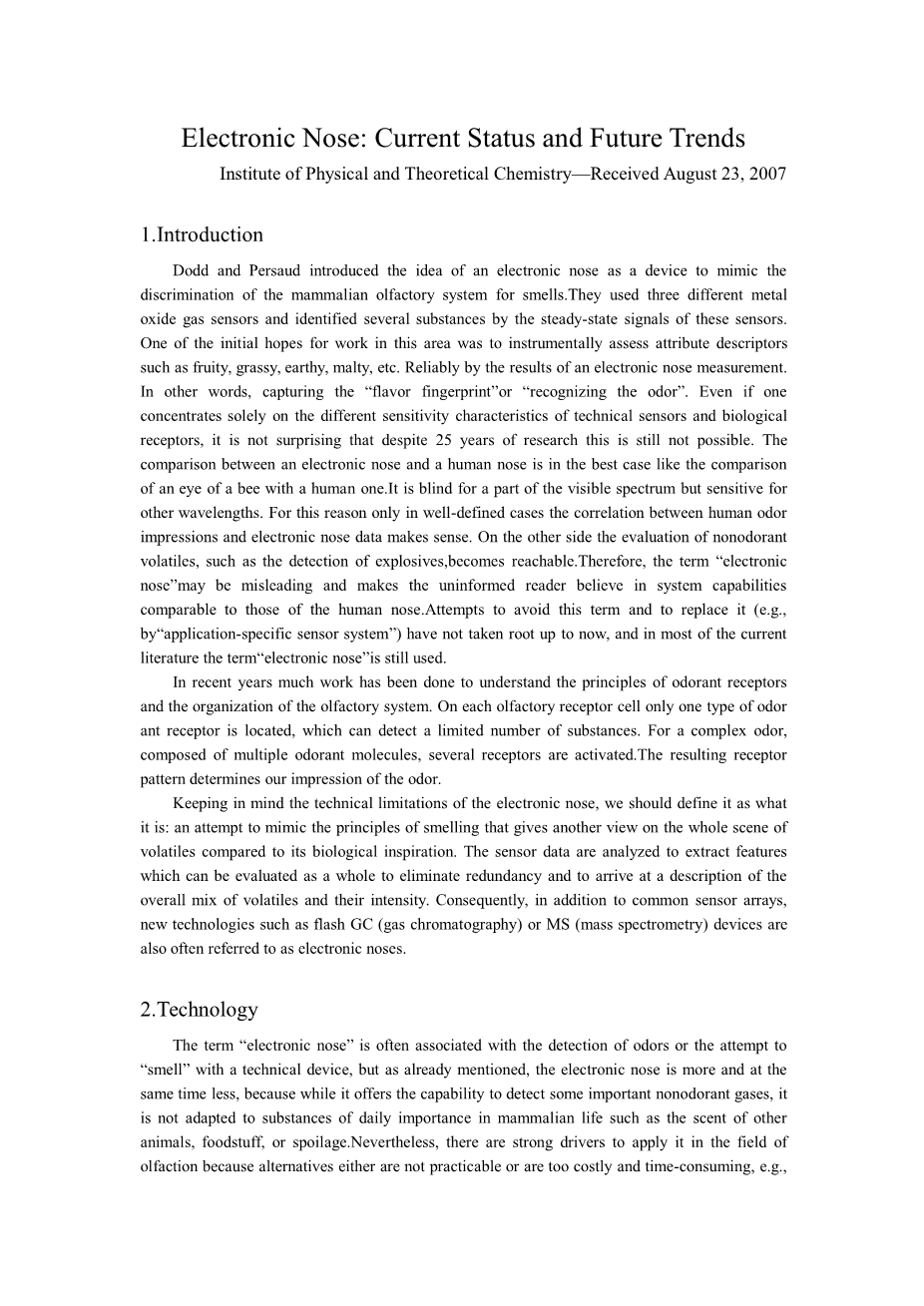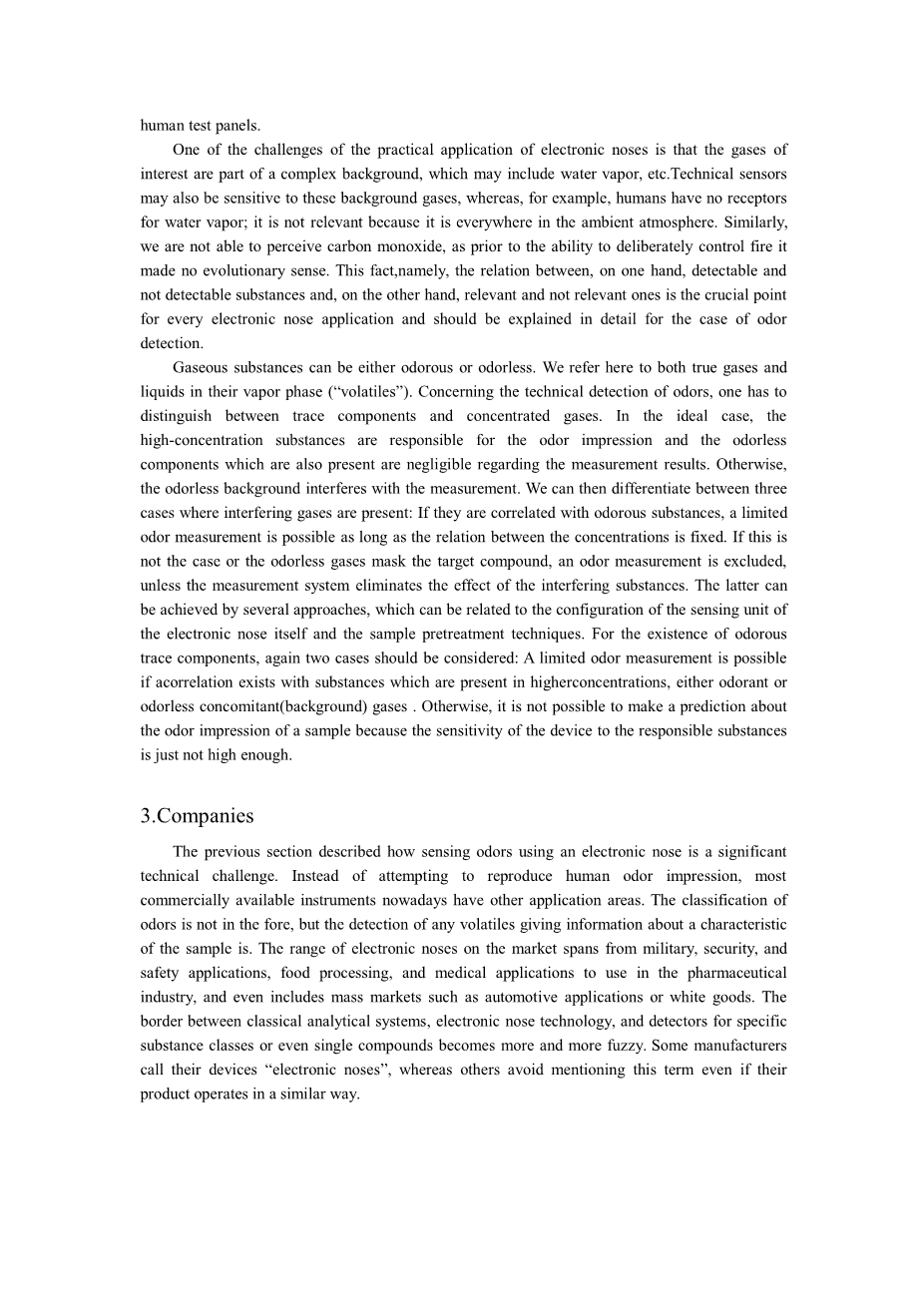

英语原文共 5 页,剩余内容已隐藏,支付完成后下载完整资料
Electronic Nose: Current Status and Future Trends
Institute of Physical and Theoretical Chemistry—Received August 23, 2007
- Introduction
Dodd and Persaud introduced the idea of an electronic nose as a device to mimic the discrimination of the mammalian olfactory system for smells.They used three different metal oxide gas sensors and identified several substances by the steady-state signals of these sensors. One of the initial hopes for work in this area was to instrumentally assess attribute descriptors such as fruity, grassy, earthy, malty, etc. Reliably by the results of an electronic nose measurement. In other words, capturing the “flavor fingerprint”or “recognizing the odor”. Even if one concentrates solely on the different sensitivity characteristics of technical sensors and biological receptors, it is not surprising that despite 25 years of research this is still not possible. The comparison between an electronic nose and a human nose is in the best case like the comparison of an eye of a bee with a human one.It is blind for a part of the visible spectrum but sensitive for other wavelengths. For this reason only in well-defined cases the correlation between human odor impressions and electronic nose data makes sense. On the other side the evaluation of nonodorant volatiles, such as the detection of explosives, becomes reachable. Therefore, the term “electronic nose”may be misleading and makes the uninformed reader believe in system capabilities comparable to those of the human nose.Attempts to avoid this term and to replace it (e.g., by“application-specific sensor system”) have not taken root up to now, and in most of the current literature the term“electronic nose”is still used.
In recent years much work has been done to understand the principles of odorant receptors and the organization of the olfactory system. On each olfactory receptor cell only one type of odor ant receptor is located, which can detect a limited number of substances. For a complex odor, composed of multiple odorant molecules, several receptors are activated.The resulting receptor pattern determines our impression of the odor.
Keeping in mind the technical limitations of the electronic nose, we should define it as what it is: an attempt to mimic the principles of smelling that gives another view on the whole scene of volatiles compared to its biological inspiration. The sensor data are analyzed to extract features which can be evaluated as a whole to eliminate redundancy and to arrive at a description of the overall mix of volatiles and their intensity. Consequently, in addition to common sensor arrays, new technologies such as flash GC (gas chromatography) or MS (mass spectrometry) devices are also often referred to as electronic noses.
- Technology
The term “electronic nose” is often associated with the detection of odors or the attempt to “smell” with a technical device, but as already mentioned, the electronic nose is more and at the same time less, because while it offers the capability to detect some important nonodorant gases, it is not adapted to substances of daily importance in mammalian life such as the scent of other animals, foodstuff, or spoilage.Nevertheless, there are strong drivers to apply it in the field of olfaction because alternatives either are not practicable or are too costly and time-consuming, e.g., human test panels.
One of the challenges of the practical application of electronic noses is that the gases of interest are part of a complex background, which may include water vapor, etc.Technical sensors may also be sensitive to these background gases, whereas, for example, humans have no receptors for water vapor; it is not relevant because it is everywhere in the ambient atmosphere. Similarly, we are not able to perceive carbon monoxide, as prior to the ability to deliberately control fire it made no evolutionary sense. This fact,namely, the relation between, on one hand, detectable and not detectable substances and, on the other hand, relevant and not relevant ones is the crucial point for every electronic nose application and should be explained in detail for the case of odor detection.
Gaseous substances can be either odorous or odorless. We refer here to both true gases and liquids in their vapor phase (“volatiles”). Concerning the technical detection of odors, one has to distinguish between trace components and concentrated gases. In the ideal case, the high-concentration substances are responsible for the odor impression and the odorless components which are also present are negligible regarding the measurement results. Otherwise, the odorless background interferes with the measurement. We can then differentiate between three cases where interfering gases are present: If they are correlated with odorous substances, a limited odor measurement is possible as long as the relation between the concentrations is fixed. If this is not the case or the od
剩余内容已隐藏,支付完成后下载完整资料
资料编号:[148776],资料为PDF文档或Word文档,PDF文档可免费转换为Word


